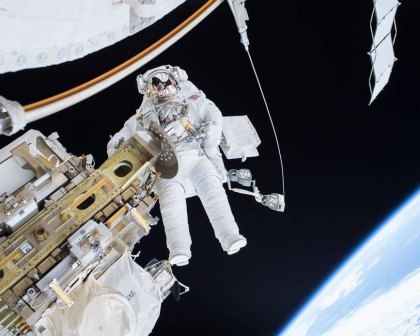Helmet malfunction ends successful spacewalk

Astronaut Tim Kopra during a spacewalk in December.
Image: NASA.
NASA astronaut Tim Kopra and England’s Tim Peake of the European Space Agency had already successfully replaced a failed voltage regulator on the International Space Station – their primary objective, according to NASA. The astronauts had ventured out of the space station and scaled to the edge of it to fix the device. Other tasks also were scheduled, but the astronauts returned to the inside of the station after water began to collect in Kopra’s helmet.
The space agency has had other problems with the spacesuits. During a July 2013 spacewalk, water began to accumulate in the helmet of ESA astronaut Luca Parmitano.
NASA engineers are investigating the incident. An agency press release said the spacewalk lasted four hours and 43 minutes and the crew was never in danger.
During an online news briefing, Kenneth Todd, operation integration manager for NASA, said the station could have continued without the equipment working, “but the reality is if we were to have an additional failure with another channel, we’d find ourselves more strapped.”
The spacewalk was set for the morning of Jan. 15. The two astronauts came out the airlock and moved down the exterior of the station.
“The work site itself is on the order of 200 feet or so from the airlock,” said Paul Dum, lead spacewalk officer.
That 200 feet would be in a straight line, but the crew had to follow the structure of the station, so the distance would probably be a little farther, he added. “It is about as far at the space station as you can go from the airlock.”
The piece of equipment is powered by solar energy, so the operation had to happen during a night pass. “It’s solar. It generates electricity out of sunlight,” explained Royce Renfrew, the spacewalk flight director. “So when it is not in sunlight, it is not generating any electricity. … Because we don’t actually know what caused it to fail. It could have a short inside it. What we don’t want to do is remove that with a potential short. If we do it during the night pass, that way we absolutely guarantee that there is no power flowing through there because there is no sun to generate electricity.”
The space agency has had other problems with the spacesuits. During a July 2013 spacewalk, water began to accumulate in the helmet of ESA astronaut Luca Parmitano.
NASA engineers are investigating the incident. An agency press release said the spacewalk lasted four hours and 43 minutes and the crew was never in danger.
During an online news briefing, Kenneth Todd, operation integration manager for NASA, said the station could have continued without the equipment working, “but the reality is if we were to have an additional failure with another channel, we’d find ourselves more strapped.”
The spacewalk was set for the morning of Jan. 15. The two astronauts came out the airlock and moved down the exterior of the station.
“The work site itself is on the order of 200 feet or so from the airlock,” said Paul Dum, lead spacewalk officer.
That 200 feet would be in a straight line, but the crew had to follow the structure of the station, so the distance would probably be a little farther, he added. “It is about as far at the space station as you can go from the airlock.”
The piece of equipment is powered by solar energy, so the operation had to happen during a night pass. “It’s solar. It generates electricity out of sunlight,” explained Royce Renfrew, the spacewalk flight director. “So when it is not in sunlight, it is not generating any electricity. … Because we don’t actually know what caused it to fail. It could have a short inside it. What we don’t want to do is remove that with a potential short. If we do it during the night pass, that way we absolutely guarantee that there is no power flowing through there because there is no sun to generate electricity.”
Related:
In Space: Emergency spacewalk completed
If you would like to comment give us a shout or like us on Facebook and tell us what you think.

